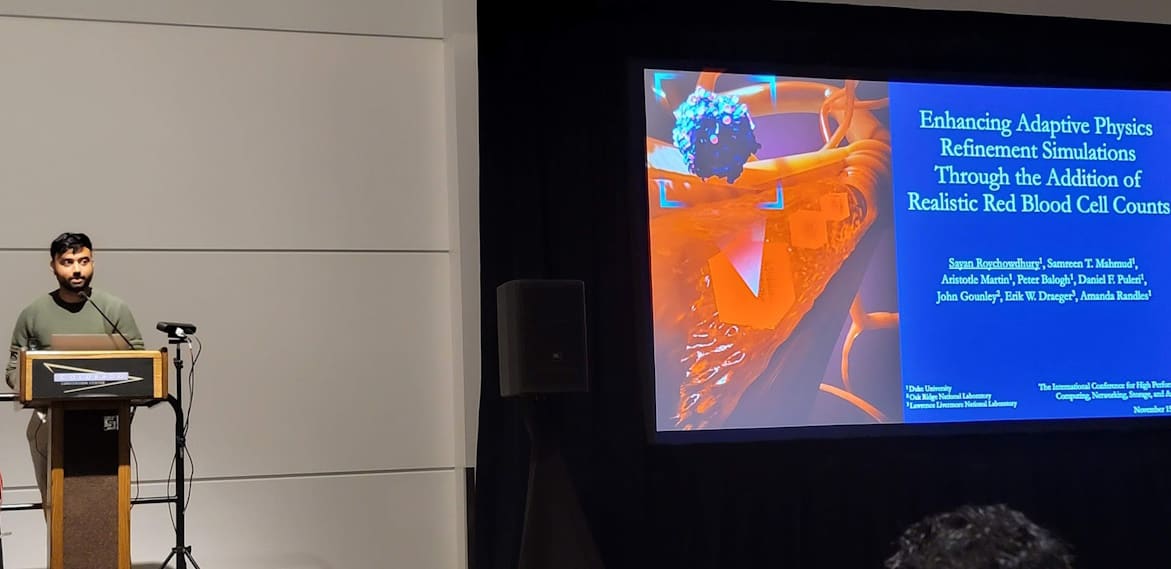Blood
Modelling a single cancer cell in a sea of blood
The SC23 conference, held earlier this month, broke previous audience records with over 14,000 attendees heading to Denver, CO, to find out about the latest achievements in high-performance computing (HPC). Like every other year, the conference hosted a variety of lectures that allowed scientists to discuss how supercomputing positively impacted their fields.
With HPC invaluable to just about every scientific domain, biological studies were well represented at SC23. One study of particular interest was the lecture presented by Sayan Roychowdhury based on the research paper “Enhancing Adaptive Physics Refinement Simulations through the Addition of Realistic Red Blood Cell Counts.”
The paper, authored mostly by Duke University scientists along with researchers from Oak Ridge National Laboratory and Lawrence Livermore National Laboratory, focuses on simulations of cancer cell transport through the upper circulatory system. The main issue, Roychowdhury explained, seems to be how far cancer cells travel compared with how small they are.
“[Cancer] hijacks the system that connects the entire body – the circulatory system,” Roychowdhury told delegates in his SC23 presentation. “These cancer cells are on the order of microns, maybe tens of microns. However, the distance they need to travel is measured in metres. We’re looking at cancer cell transport over long distances.”
Relying on a hybrid CPU–GPU (central processing unit–graphics processing unit) architecture on the Summit supercomputer – including 1500 GPUs and 10,800 CPUs – the team was able to extend their adaptive physics refinement (APR) method to track an individual cancer cell as it moved through the bloodstream.
Different resolutions for different results
Among many concerns when it comes to cancer, one major issue is how cancer cells can metastasize and spread throughout the body. As the researchers point out in their paper, metastasis is the underlying cause of over 90% of cancer-related mortalities.

To understand this process further, the researchers applied the APR method to combine a finely resolved region of red blood cells with a coarsely resolved bulk fluid domain. In essence, they took a grid that represented a high-resolution model of red blood cells and moved it through a simulated low-resolution version of an upper body vasculature. The hybrid nature of the computing architecture was important here, as the CPUs were used for the coarsely resolved surrounding area while the GPUs focused on the finely resolved grid.
This grid contained the cancer cell, along with a high-resolution model of the red blood cells that surround it as it moves through the circulatory system. As the cancer cell moved, the grid moved along with it. This approach ensured that the area surrounding the tiny cancer cell was modelled as finely as possible without wasting compute resources on areas in the circulatory system not immediately surrounding the cancer cell.
There were many other important aspects of this work, including the accurate deformation of red blood cells as they flow through the circulatory system, as well as the boundary between the finely resolved grid and the coarsely resolved area outside the grid.

Soft-matter physics helps reveal whether cancers are likely to spread
One of the most significant points of this research, Roychowdhury noted, is that the advanced APR method can simulate cancer cell transport using a fraction of the computational power required to run a fully resolved model. “A simulation like this, that should take thousands of nodes, can be shrunk down to just use one,” he said. “Our goal is to make these HPC simulations accessible to scientists.”
There is future work to be done. The team’s current research only focuses on a single cancer cell, while these cells generally break off in clusters rather than singularly. Responding to a question from the audience, Roychowdhury stated that the team is also interested in further research in this area concerning sickle cells.

